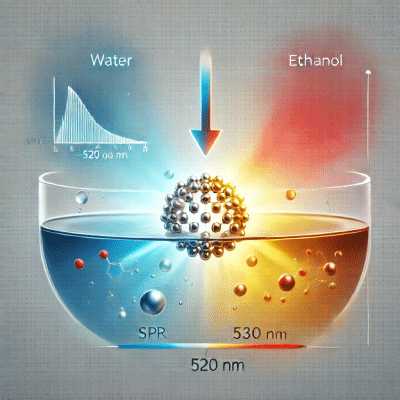The Effect of the Index of Refraction on Surface Plasmon Resonance (SPR) | Nanopartz™
Introduction
Surface plasmon resonance (SPR) is a fascinating phenomenon observed in nanoparticles, particularly in metals like gold and silver. This effect occurs when free electrons on the nanoparticle surface resonate with incident light, leading to a strong absorption or scattering peak at a specific wavelength. The exact wavelength of this resonance is highly dependent on the index of refraction of the surrounding medium.
Understanding how the refractive index influences SPR is critical for many applications, including biosensing, medical imaging, and material science. This article explores the underlying physics of this relationship, practical implications, and real-world applications.
SPR Calculation Formula
λSPR,new = λSPR,water × (nnew / nwater)
Where:
- λSPR,new: Resultant SPR wavelength in the new medium.
- λSPR,water: Initial SPR wavelength in water.
- nnew: Refractive index of the new medium.
- nwater = 1.3335: Refractive index of water.
The Physics Behind SPR and Refractive Index
The SPR wavelength is determined by the interaction of light with the free electrons in the nanoparticle. The resonance condition depends on the dielectric constants of both the nanoparticle material and the surrounding medium. The index of refraction (n) of the medium affects the dielectric environment and shifts the SPR wavelength accordingly.
As the refractive index increases, the dielectric environment changes, leading to a red shift (increase in SPR wavelength). Conversely, a decrease in the refractive index results in a blue shift (decrease in SPR wavelength).

Experimental Observations of SPR Shifts
Consider a gold nanoparticle in water (n=1.333). If the surrounding medium changes to ethanol (n=1.36), the SPR peak shifts to a longer wavelength due to the higher refractive index. Such shifts are measurable using spectrophotometers and are the foundation of SPR-based sensors.
The Physics Behind SPR and Refractive Index
-
Biosensing:
SPR sensors detect changes in refractive index caused by molecular binding events. For example, when an antibody binds to its antigen on a nanoparticle surface, the refractive index changes, shifting the SPR wavelength. This principle is used in detecting biomarkers for diseases. -
Medical Imaging:
Gold nanoparticles, whose SPR is tuned by the surrounding refractive index, enhance imaging contrast in techniques like photoacoustic imaging and X-ray imaging. -
Environmental Monitoring:
SPR sensors measure pollutants by detecting refractive index changes in the surrounding medium.
Factors That Influence SPR Shifts
-
Nanoparticle Size and Shape: Larger nanoparticles or anisotropic shapes (e.g., nanorods) exhibit more significant sensitivity to refractive index changes.
-
Medium Properties: Solvents with higher refractive indices cause larger red shifts in SPR.
-
Temperature: Changes in temperature can alter the refractive index of the medium and the nanoparticle properties, affecting SPR.
Available Gold Nanoparticle Products from Nanopartz
Nanopartz offers a variety of gold nanoparticle products tailored specifically for SPR detection in different mediums
For more information and to explore their products, visit the Gold Nanoparticles. Happy researching!

